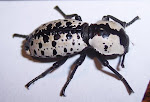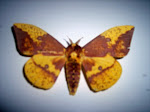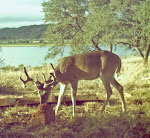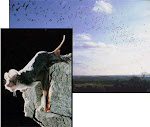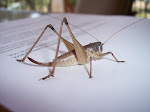Issue 3- July 19, 2009 Raccoons
Well, GOOOD MORNING Mystic Shores! That probably reminds Fred and Tom of Adrian Cronauer, but those of you who weren’t in country in ’65 won’t have a clue as to what I’m talking about. Anyway, last night I decided to write this issue of ‘Our Creatures’ about my favorite rascal, the Raccoon. Just for kicks I thought I’d set out my large live trap, bait it with a little peanut butter, and see if I can get a recent picture for the article. As soon as the sun comes up, I’ll know if I caught one or not. Chances are pretty good, since there are so many coons moving up and down the river and I haven’t put out the trap in a long while. Need to get that coffee in me first, however, because raccoons are tough, scrappy little fighters and I need to be alert when I release it. An angry ‘coon might just decide to take a bite out of my ankle for inconveniencing him.
Well, sun’s up and the raccoons came and left, without getting caught this time. They really are clever little scavengers and can reach into tiny little spaces with their front paws and grab things, even though they don’t have opposable thumbs. In this case, they reached between the wires of the live trap and took the bait without going inside. So, no close-up pictures this issue. I’ll substitute a picture I took with my trail camera in the backyard a couple of months ago.
Note that there are five raccoons in the picture. You’ll also note that they look like they are in pretty good shape and their fur is full and healthy. Due to this drought we’re having, the raccoons now look scruffier and thinner. They, along with a lot of the other wild animals, are stressed now because of the prolonged heat and lack of moisture.
The common raccoon (Kingdom; Animalia, Phylum; Chordata, Class; Mammalia, Order; Carnivora, Family; Procyonidae, Genus: Procyon, Species: P. lotor) is a medium sized mammal originally native to deciduous North American forests. The first recorded written record of the raccoon was actually done by Christopher Columbus at the end of the fifteenth century. In the centuries since, the raccoons have proven so adaptable that they are now found throughout most terrains in North America, and have been introduced into Europe and Japan.
Raccoons are nocturnal omnivores. They can eat most anything and their diet consists of roughly a third plant matter (acorns are a favorite), a third invertebrates (insects and grubs mostly) and a third vertebrates (fish, for example). They frequently travel along the edges of waterways searching for food and their tracks are easily seen in the mud down by the edge of Canyon Lake or the Guadalupe River.
The average coon in the Hill Country might go 10 pounds but their weights can vary widely. This variation is not only between individuals but also is very much dependent upon the time of the year. During a ‘normal’ year, the raccoons might loose half their body weight over the winter. Males are about a fifth larger than females. All, however, have a distinctive ‘mask’ that contributes to their reputation of being inquisitive little bandits.
The females live their lives in a relative small territory, probably a square mile or two in our country. The males extend into larger areas, particularly during the mating season in the winter. They often share ‘latrines’ in overlapping territories and these markers can be found readily as you walk around the peninsula. I have noted many stumps or rock outcroppings where they leave concentrations of urine and feces. Reportedly, the raccoons meet at these areas for collective eating, sleeping and playing. After breeding in February and a two month gestation period, the females have between 2 and 5 young, which they care for until the fall. Tree hollows in old oaks and rock crevasses are favorite den sites and of course we have an abundance of both here at Mystic Shores.
Raccoons are good climbers and have the unusual ability (for mammals, anyway) of being able to climb down a tree trunk headfirst. To do this, they rotate their hind feet so they are pointing backwards. They can sprint up to 15 miles per hour but their body shape is not conducive to being fast runners. They are, however, excellent swimmers and can stay in water for hours, if necessary.
They have five digits on their paws and all carry non-retractable claws. Their sense of touch is very highly developed and has been studied extensively.
Raccoons are quite vocal and communicate with one another frequently. I often hear them chittering away while sitting on my back porch at night. They reportedly have 13 identified calls, seven of which are used between the mother and kits. The sound I can identify most readily is the birdlike twittering of young ones.
The life expectancy of raccoons in the wild is only 2 to 3 years, and run-ins with cars account for many, if not most, of the deaths.
The most frequent natural cause of death in raccoons is distemper and this particular pathogen does not affect humans. However, they can also carry rabies, which is a potentially lethal disease carried in raccoons’ saliva and transmitted through their bites. There is only one human fatality that has ever been reported after transmission of the rabies virus from raccoon. Nevertheless, if any abnormal behavior or appearance is noted in an animal, the U.S. Forest Service recommends that we notify the proper authorities, such as an animal control officer from the local health department. Since healthy animals, especially nursing mothers, will occasionally forage during the day, daylight activity is not a reliable indicator of illness in raccoons.
Barbequed raccoon might not sound too appetizing but it was a rural staple in much of the south for many years. Since we generally think of them as varmints now, the idea of eating them is no longer part of mainstream culinary thinking.
It wasn’t too long ago that a farm boy could make good spending money off of ‘coons with a decent dog and a 22 rifle. Through the seventies and eighties, it was not unusual to bring in $20 for a good pelt and millions of them were hunted. You might find it interesting to learn that Davy Crockett probably never wore a coonskin cap. Fes Parker certainly did……. I remember the film and TV series.
If you want to see raccoons here at Mystic Shores, it’s really quite simple. Just leave your trash can open after dark and flip on the garage light when you hear a racket. You’ll likely find a family of raccoons pulling apart the hefty bags and making a nuisance of themselves. Yep, they can be rascals, but they are a fascinating animal and a big part of the dynamic whirl of wildlife that surround us here at Mystic Shores.
Clay
PS I take pictures of a lot of our wildlife with trail cameras. I have infrared as well as daylight and flash versions. I have never caught a mountain lion on film, at least not here at Mystic Shores. If you see one, or if you suspect one is traveling through your property, please send me an email. I’d love to document a sighting and write up an article on it.
Sunday, July 19, 2009
Monday, July 6, 2009
Issue 2 - Osprey
Issue 2- July 6, 2009 Osprey
The last thing my buddy Paula said to me yesterday was “Did you finish the next issue of ‘Our Creatures, Great and Small’ yet? She will probably ask the same thing when we talk later this morning. Maybe by that time I’ll be able to give her a different answer.
It’s about five thirty and still dark outside, but the coffee is on. It’s not ready yet, but it’s sure starting to smell good. I’m a patient guy so I’ll just sit here and wait for the day to start and the coffee to brew. In the meantime, I’ve got my laptop out and I’ll just sit here at the breakfast table on the side facing the windows. I know Canyon Lake is a hundred yards down there in the dark because I’ve watched it through these same windows for over a year now, ever since Pat and I moved to Mystic Shores. Actually, my back windows overlook the Guadalupe River and the lake proper begins a little downstream to the east, near Marty and Barbara’s. Never-the-less, the fishing is good just below the house, with lots of structure like trees sticking up now that the water level is so low. The lights on the porches of the homes a mile across the west bay of the lake are starting to wash out, just like the stars did a few minutes ago. It is early yet, but starting to get light now, even though the sun hasn’t cleared the live oak ridge to the east. If I stepped out on the porch, I’m sure that I could hear the birds chirping and welcoming another day.
The light is coming up faster now and you can just start to see the mist streaming off the water around the stumps on this side of the old river channel. I bet I could see it better if I had some coffee in me. Anyway, that mist will burn off pretty quick once the sun gets up. It always does here in the Hill Country of Texas. Must be the low humidity. I hope the sea-hawks, the Ospreys, decide to hunt from the big Cypress snag on my side of the river this morning. I have a clear view of it from this window and my binoculars are sitting right there on the window sill. I just have to be patient, because they are diurnal hunters and won’t show up until it’s pretty light out. I don’t have real high hopes, however. They haven’t been using that snag all that much since the water level has dropped and the shoreline has moved out thirty yards. There is probably a better vantage point up river now where their hunting perch is closer to the action. Last summer they were here almost every day, and it’s great fun to watch them hover like delicate eagles in their search for a fish for breakfast.
As you can see, I’m a morning person and I’m a nature person. It is not so obvious that I’m also a little selfish, but I’m trying to work on that. I’m selfish because I’ve been keeping these Ospreys as my own private little secret for about a year now. (They have been great therapy, I can assure you, and I needed some after the presidential election and the Wall St mess.) Anyway, I don’t think too many people in our neighborhood know about them. Some of the fishermen probably do. Certainly nobody else watches them as much as I do. So, what is the big deal and what is there to share? I’ll let you know as soon as I drink this coffee…..
OK, the coffee now has a stronghold. These Ospreys are just too cool! Mother Nature did an extraordinary job on this critter. They are beautiful, graceful, functional and deadly. Look at this photo……. How majestic is that? They have a wingspread of almost six feet and a body about two feet long. The white chest and head are in distinct contrast to the black wings and black eye patch. They look like they mean business, and their business is catching fish.
(Kingdom; Animalia, Phylum; Chordata, Class; Aves, Order; Accipitriformes, Family; Pandionidae, Genus: Pandion, Species: P.Haliaetus)
These raptors have an array of features, some unique to their genus, that make them super efficient at catching fish. Allow me to go into some detail.
Their eyesight is extraordinary compared to ours. They can distinguish objects ten times better and farther away than we can. No wonder they can see a fish a foot under the surface of the lake while flying fifty feet above the surface.
Ospreys are one of the few birds that will actually go into the water to grab a fish. Eagles, for example, only skim the surface and grab a fish as they fly over. Ospreys actually go feet first into the water and can go in three feet deep after their prey. (They have closable nostrils to keep out water during these dives.) They often target fish in the 12-14 inch range.
Their talons are adapted just for fishing. They have backward facing scales that act like barbs and help them hold onto the fish. Reversible outer toes give them an optimum grip and allow them to rotate their prey headfirst so there is less drag and it is easier for them to fly away. I’ve seen this a couple of times on our river and it is fascinating to watch. Keep in mind that these birds, although large and powerful, only weigh about four pounds. It takes quite an effort for them to get airborne with a large fish and the way they spin them around and face them forward to make them more aerodynamic is fascinating.
The Ospreys are easy to distinguish from other large birds around the lake. They can hover, which they often do before they begin their dive after prey. Their wings are long and angular and they leave their talons down when they fly, giving them, in my opinion a little bit of a ‘gull’ look.
Their tail is short and the four long ‘finger’ feathers at the end of their wings are distinctive.
Their call is a series of sharp whistles.
Here in our area, we are far enough south that some may stay year round, but normally they migrate to South America during the winter.
Ospreys are great at raising a family. In the spring, they make massive nests out of sticks (often six feet in diameter) and will return to the same nest and rebuild it year after year. (There is a nest about four hundred yards south of Doug and Lisa’s home on the other side of the river.)
The females lay two to four eggs along about April and they hatch after five weeks. The parents share the feeding duties. The Osprey male and female mate for life (a good thing in my opinion) and often live to twenty or twenty five years of age.
They have few natural enemies. An occasional chick is probably taken by owls but other than that, they are near the top of the food chain.
Ospreys are not endangered and are pretty widespread throughout our country and indeed the world. The species can be found on all continents except Antartica. Back in the fifties they were quite subject to the DDT that was used at the time as a pesticide. It made the shells of their eggs weak and the mortality was extremely high. However, their numbers have recovered and this magnificent bird is not in any danger of extinction. There are just four subspecies worldwide and of course our local version is the biggest and best. It has to be……. it is Texan, you know.
Well, the Ospreys haven’t shown up yet this morning and there are other things to do today. To wrap up this issue of “Our Creatures, Great and Small” keep in mind that we are the stewards of our wildlife here in Mystic Shores. That means we are also responsible for sharing and perpetuating this heritage. What’s it worth to show these magnificent birds to the next generation?
Clay
The last thing my buddy Paula said to me yesterday was “Did you finish the next issue of ‘Our Creatures, Great and Small’ yet? She will probably ask the same thing when we talk later this morning. Maybe by that time I’ll be able to give her a different answer.
It’s about five thirty and still dark outside, but the coffee is on. It’s not ready yet, but it’s sure starting to smell good. I’m a patient guy so I’ll just sit here and wait for the day to start and the coffee to brew. In the meantime, I’ve got my laptop out and I’ll just sit here at the breakfast table on the side facing the windows. I know Canyon Lake is a hundred yards down there in the dark because I’ve watched it through these same windows for over a year now, ever since Pat and I moved to Mystic Shores. Actually, my back windows overlook the Guadalupe River and the lake proper begins a little downstream to the east, near Marty and Barbara’s. Never-the-less, the fishing is good just below the house, with lots of structure like trees sticking up now that the water level is so low. The lights on the porches of the homes a mile across the west bay of the lake are starting to wash out, just like the stars did a few minutes ago. It is early yet, but starting to get light now, even though the sun hasn’t cleared the live oak ridge to the east. If I stepped out on the porch, I’m sure that I could hear the birds chirping and welcoming another day.
The light is coming up faster now and you can just start to see the mist streaming off the water around the stumps on this side of the old river channel. I bet I could see it better if I had some coffee in me. Anyway, that mist will burn off pretty quick once the sun gets up. It always does here in the Hill Country of Texas. Must be the low humidity. I hope the sea-hawks, the Ospreys, decide to hunt from the big Cypress snag on my side of the river this morning. I have a clear view of it from this window and my binoculars are sitting right there on the window sill. I just have to be patient, because they are diurnal hunters and won’t show up until it’s pretty light out. I don’t have real high hopes, however. They haven’t been using that snag all that much since the water level has dropped and the shoreline has moved out thirty yards. There is probably a better vantage point up river now where their hunting perch is closer to the action. Last summer they were here almost every day, and it’s great fun to watch them hover like delicate eagles in their search for a fish for breakfast.
As you can see, I’m a morning person and I’m a nature person. It is not so obvious that I’m also a little selfish, but I’m trying to work on that. I’m selfish because I’ve been keeping these Ospreys as my own private little secret for about a year now. (They have been great therapy, I can assure you, and I needed some after the presidential election and the Wall St mess.) Anyway, I don’t think too many people in our neighborhood know about them. Some of the fishermen probably do. Certainly nobody else watches them as much as I do. So, what is the big deal and what is there to share? I’ll let you know as soon as I drink this coffee…..
OK, the coffee now has a stronghold. These Ospreys are just too cool! Mother Nature did an extraordinary job on this critter. They are beautiful, graceful, functional and deadly. Look at this photo……. How majestic is that? They have a wingspread of almost six feet and a body about two feet long. The white chest and head are in distinct contrast to the black wings and black eye patch. They look like they mean business, and their business is catching fish.
(Kingdom; Animalia, Phylum; Chordata, Class; Aves, Order; Accipitriformes, Family; Pandionidae, Genus: Pandion, Species: P.Haliaetus)
These raptors have an array of features, some unique to their genus, that make them super efficient at catching fish. Allow me to go into some detail.
Their eyesight is extraordinary compared to ours. They can distinguish objects ten times better and farther away than we can. No wonder they can see a fish a foot under the surface of the lake while flying fifty feet above the surface.
Ospreys are one of the few birds that will actually go into the water to grab a fish. Eagles, for example, only skim the surface and grab a fish as they fly over. Ospreys actually go feet first into the water and can go in three feet deep after their prey. (They have closable nostrils to keep out water during these dives.) They often target fish in the 12-14 inch range.
Their talons are adapted just for fishing. They have backward facing scales that act like barbs and help them hold onto the fish. Reversible outer toes give them an optimum grip and allow them to rotate their prey headfirst so there is less drag and it is easier for them to fly away. I’ve seen this a couple of times on our river and it is fascinating to watch. Keep in mind that these birds, although large and powerful, only weigh about four pounds. It takes quite an effort for them to get airborne with a large fish and the way they spin them around and face them forward to make them more aerodynamic is fascinating.
The Ospreys are easy to distinguish from other large birds around the lake. They can hover, which they often do before they begin their dive after prey. Their wings are long and angular and they leave their talons down when they fly, giving them, in my opinion a little bit of a ‘gull’ look.
Their tail is short and the four long ‘finger’ feathers at the end of their wings are distinctive.
Their call is a series of sharp whistles.
Here in our area, we are far enough south that some may stay year round, but normally they migrate to South America during the winter.
Ospreys are great at raising a family. In the spring, they make massive nests out of sticks (often six feet in diameter) and will return to the same nest and rebuild it year after year. (There is a nest about four hundred yards south of Doug and Lisa’s home on the other side of the river.)
The females lay two to four eggs along about April and they hatch after five weeks. The parents share the feeding duties. The Osprey male and female mate for life (a good thing in my opinion) and often live to twenty or twenty five years of age.
They have few natural enemies. An occasional chick is probably taken by owls but other than that, they are near the top of the food chain.
Ospreys are not endangered and are pretty widespread throughout our country and indeed the world. The species can be found on all continents except Antartica. Back in the fifties they were quite subject to the DDT that was used at the time as a pesticide. It made the shells of their eggs weak and the mortality was extremely high. However, their numbers have recovered and this magnificent bird is not in any danger of extinction. There are just four subspecies worldwide and of course our local version is the biggest and best. It has to be……. it is Texan, you know.
Well, the Ospreys haven’t shown up yet this morning and there are other things to do today. To wrap up this issue of “Our Creatures, Great and Small” keep in mind that we are the stewards of our wildlife here in Mystic Shores. That means we are also responsible for sharing and perpetuating this heritage. What’s it worth to show these magnificent birds to the next generation?
Clay
Subscribe to:
Posts (Atom)
